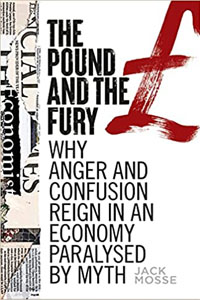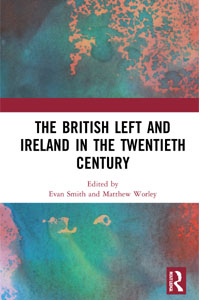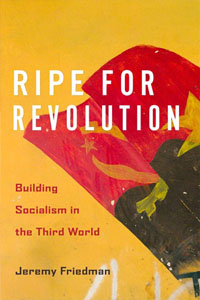Book Reviews – The Pound and the Fury / The British Left and Ireland / Ripe for Revolution: Building Socialism in the Third World
Confusion compounded
 The Pound and the Fury. Why Anger and Confusion Reign in an Economy Paralysed by Myth. By Jack Mosse. 168 pages. Manchester University Press, 2021.
The Pound and the Fury. Why Anger and Confusion Reign in an Economy Paralysed by Myth. By Jack Mosse. 168 pages. Manchester University Press, 2021.
To explain why ‘for decades, our economy has failed to work for ordinary citizens’, Mosse had the idea of asking various groups of people what they thought the ‘economy’ was and how they thought it worked. He interviewed people on a nearby estate, people working in asset management, civil service economists, and journalists on a magazine advising small investors. It worked and makes interesting reading. Those in the estate thought that the economy is a conspiracy of the rich and powerful to keep them poor; the asset managers and civil servants saw it as ‘an autonomous natural entity’; the financial journalists came across as simple conmen.
The trouble is that Mosse himself is confused about economics, as revealed by his comments on the answers and in his final chapter on ‘Demythologising the economy’. Early on (p.27) he states his belief that ‘money can be magicked up out of thin air’ by banks. In fact, some of those he interviewed had a more accurate understanding than he does.
He criticises the asset managers and the civil servants for ‘reifying’ the economy ‘as an entity operating according to its own autonomous logic‘ with the result that ’human actors are understood as merely complying with the irresistible base force that drives the economy’ (p. 60-1).
Actually, that is not a bad description of how the capitalist economy does operate. Human actors (capitalists, workers, governments) do have to submit to the logic of the system in the end. The asset managers and civil servants misunderstand the system as an expression of human nature. Mosse calls seeing the economy as an autonomous natural force ‘reifying’. The word Marx used was ‘fetishism’ – humans attributing autonomous power to and being dominated by something that ultimately they create. Humans could cease to be dominated by the outcome of their activity if they changed that activity from producing wealth for sale on a market with a view to profit to producing directly to satisfy people’s needs. This is possible only on the basis of the common ownership and democratic control of productive resources; with this, the ‘economy’ would then cease to operate and humans would be in control of what they produce.
Mosse’s alternative proposal is just to tinker with the banking system while leaving the rest of capitalism unchanged. He attributes to private banks a power which they do not possess. When he says that ‘governments, as well as private banks, create money out of nowhere’, he is only half right. The government, normally via its central bank, can create money, or at least money-tokens, at will (but this will have consequences). Banks cannot. They can only lend what they have themselves borrowed; they don’t create new money, they only redistribute money that already exists. The myth that they can create money out of thin air arises because modern economics has come to define making a bank loan as ‘creating’ money. Banks do make loans of course but not out of thin air.
Having two different definitions of money creation only causes confusion of which Mosse is a victim. He needs to explain, if banks can ‘magic money out of thin air’, how come that during the crash of 2008 they had to be bailed out by the government? Why did they not use their supposed ability to create money to bail themselves out?
He gets himself into another contradiction when discussing one of the reforms proposed by Positive Money – ‘to ban private credit creation’ (p. 137). This turns out not to be stopping banks lending altogether (as it ought logically to mean if banks create money whenever they make a loan), but to allow them to re-lend only money deposited with them. This would mean that they would no longer be able to use the money market to borrow money from other banks and financial institutions to re-lend. Mosse concedes that this ‘draconian policy’ would provoke ‘a huge immediate shock effect on all kinds of economic activity, which would dwarf any previous banking crisis’. Yes, it would.
Seeming to realise the impracticality of that particular money reform, he turns to another funny money theory, so-called ‘Modern Monetary Theory’. MMT is based on the fact that governments do have the power to create money-tokens out of nothing. It argues that all a government has to do is to decide what it wants to spend money on and then create the money; governments don’t really need either to tax or to borrow. Given certain unrealistic conditions a government could perhaps do this but the most likely outcome would be Zimbabwe-style roaring inflation.
It is a pity than Mosse has let himself be influenced by monetary reformers and so ends up propagating confused and confusing myths himself. Despite this, the chapters – four-fifths of the book – where he interviews people are worth reading as good reporting.
Confusing nationalism with socialism
 The British Left and Ireland in the twentieth century. Edited By Evan Smith and Matthew Worley. Routledge. 2021. 186 pages. ISBN 9780367701468.
The British Left and Ireland in the twentieth century. Edited By Evan Smith and Matthew Worley. Routledge. 2021. 186 pages. ISBN 9780367701468.
From the middle of the 19th century onwards, a view took hold in sections of radical opinion in Britain that support for the Irish separatist movement would promote social revolution in Britain itself and in turn hasten the establishment of socialism there. The supposition was that if Ireland regained its independence from England, then that would significantly weaken the British ruling class. The hope being that the overthrow of British rule in Ireland would deal such a blow to the confidence of the British capitalist class, and particularly its imperialist faction, that it would prepare the ground for socialist change in Britain. The natural extension of this idea was that the Left in Britain should support the campaign for Irish independence. After the Anglo-Irish settlement of 1921, that aim became modified to mean supporting the ending of British rule in Northern Ireland.
As a political theory, the concept doesn’t appear to have passed the test of history, at least judged from today’s perspective. Like Northern Ireland, the Republic of Ireland has just marked its centenary as a capitalist state. Over that period, it has had times of relative success and failure but its slow evolution to a fully independent capitalist state has never had any permanent or profound impact on left-wing politics in Britain. However as with many of these political theories, a case can be always be made for it at some level, meaning that it has never entirely been debunked and still has its adherents even today. This aspiration helps explain the enduring interest that a variety of left-wing groups have had in Ireland over the past 150 years or so and the book explores aspects of this relationship. At the outset, it must be said that the book is quite academic in nature and seems aimed at the reader with a very specialised interest in this topic. It consists of seven quite disparate chapters; five cover the period from 1900 to 1960 while the remaining two are associated with the more recent troubles in Ulster. The book does lack an overall narrative to put each chapter in a historical context and it is assumed that the reader has a good pre-existing knowledge of radical Anglo-Irish relations.
The classification ‘British Left’ is taken to exclude the Labour Party so the book just concentrates on what is more conventionally termed the ‘British Far Left’ consisting of a variety of ‘orthodox’ Communist parties and Trotskyist groups. The exclusion of the interactions between the Labour Party and Ireland from analysis has the unfortunate result that the more tangible and permanent manifestations of the British Left-Ireland relationship are not analysed. Seminal events such as the Blair Government and the Good Friday Agreement of 1998 and before that the Ireland Act (1949) of the Attlee Government are not discussed. Even the connections between the ‘far left’ of the Labour Party and Irish nationalism are not examined. This results in the somewhat strange fact that there is no mention of either Jeremy Corbyn or Ken Livingstone in the book, apart from a passing mention at the end of one of the chapters to the former. These must be two of the more well-known, recent left-wingers associated with the cause of Irish separatism and their omission is a weakness. Both men offered a critique of Britain’s policy in Northern Ireland which to the Tory tabloid press was equated to full-blooded support for the IRA’s campaign of indiscriminate bombing in British cities.
The focus on the operations of small groups from the ‘Marxist’ tradition of the British Left is mirrored in the book’s approach to politics across the Irish sea by a similar focus on very small and now defunct left-nationalist parties that have existed in Ireland over the last 100 years. There is very little analysis of Sinn Fein’s relationship with the British Left which is equally peculiar given that party can almost certainly claim to have been the standard bearer of muscular Irish Nationalism in the 20th century. So the most important relationship in this context existing between the (British) Labour Party and Sinn Fein is not discussed.
The book primarily deals with the very many, small left-wing groups that have existed in Britain over the last hundred years, most of them now disbanded and forgotten except by historians. One of the recurring themes is the uneasy relationship between the official Communist parties of both countries with the Communist Party of Ireland feeling at times patronised by the CPGB and the Dublin comrades being disappointed with the level of support given to them from London in their efforts to link the class and national struggles here. Most of the left parties in Britain did support, to some extent at least, Irish nationalism; this they tended to do with varying levels of commitment and enthusiasm; the orthodox Communist parties were more circumspect than many of the Trotskyist groups. For some of the latter groups, support for the IRA’s armed campaign was justified as part of the support given to national liberation struggles of colonised peoples and the idea from Lenin that even exclusively national liberation movements in the colonised world would spark socialist revolution in the home countries.
While in the main, the book only highlights the connections between leftists on both islands, there is some tangential discussion on how right-wing or conservative politics responded to this British Left – Ireland relationship. Two chapters explore the operation of anti-communism in Britain and Ireland. The first describes the actions of the Catholic Church and Catholic ideologues in fomenting cold war suspicions of the left-wing Connolly Association which enjoyed some support from politically aware Irish emigrants in Britain in the post-war era. Another chapter, from the same time, discusses the efforts of the establishment on both sides of the sectarian divide in Northern Ireland to dissuade workers from voting for ‘communist parties’ in the post-war period. One other issue that the book covers is the intersection of socialism and identity politics. Two chapters, separated historically by 60 years or more, deal with the impact of feminism on the relationship. The first considers the attitudes of British suffragettes to the Irish question in the Edwardian period while the second explores the outlook of British feminists to the plight of women republican prisoners in jail in Northern Ireland in the 1970s. Just as the main storyline of the book is concerned with enquiring into the association between national liberation and social change, these chapters include the extra question of whether women’s emancipation could or should be pursued separately to both or either national liberation and socialist revolution.
In summary, while the book itself seems scholarly and well-researched and sympathetic to the movements it describes, its remit is very narrow. From our perspective, the book is essentially a history of the futility of confusing socialism and nationalism in suggesting to workers that nationalism can be a pathway to socialism. The political groups and the actions they engaged in, that are listed in the book, were generally divorced from the concerns of the main body of the Irish people and entered little into mainstream consciousness. There is not much evidence of any lasting impact on politics in Ireland today. Also, the Republican movement itself in Ireland has moved between holding leftist reformist progressive positions to being quite a conservative, nationalist movement and provoking the question why it should be supported by people with socialist opinions.
KEVIN CRONIN
Not revolution at all
 Ripe for Revolution: Building Socialism in the Third World. By Jeremy Friedman. Harvard University Press £28.95.
Ripe for Revolution: Building Socialism in the Third World. By Jeremy Friedman. Harvard University Press £28.95.
This book covers attempts to build so-called socialism in developing countries. Case studies deal with Indonesia, Chile, Tanzania, Angola and Iran, each supported by a great deal of detailed documentation. It is not about socialism at all, of course, but still contains a lot of useful information and interesting discussion, about such topics as rivalry between the rulers in Moscow and Beijing, and the use or not of parliament.
The examples are very different from each other. In Indonesia the ‘Communist’ Party (PKI) was not in power, but Russian aid was supposed to help build heavy industry and so increase the role of the working class. Sukarno’s dictatorship eventually resulted in the killing of perhaps half a million PKI members and supporters. In Chile Allende ‘saw himself as creating a completely new model of socialist revolution’, but he was not in full control of the Congress and was able to do little more than nationalise the copper industry. The end in 1973 was another coup and thousands of deaths. Nyerere in Tanzania claimed to want socialism without class struggle, but his agricultural reforms (‘forced villagization’) led to a drop in production and massive food imports. In Angola there were competing ‘liberation movements’ and from the mid-70s there was a combination of ‘political Leninism with a mixed economy’, resulting in a ‘Leninist oligarchy’ that skimmed profits and preserved its political power. Despite its vast oil resources, the country exemplified ‘Leninist capitalism’, where a kleptocracy justified itself on the grounds of national development. Iran shared with Indonesia the influence of Islam, but land reform was not implemented, and the idea that an Islamic state would mean a more just economic system proved baseless.
Friedman concludes that the Russian rulers’ idea of state-led industrialisation did not deliver what was promised, and so the market had to be re-introduced (not that it had ever gone away). He talks briefly about various definitions of socialism, but does not refer to the idea of a classless stateless global society. He sees the ‘Leninist model of politics’ as an enduring legacy, and a number of organisations built on such lines still hold power in southern Africa. The Cold War did not end so clearly in the less developed parts of the world, but the claim in the final paragraph that ‘the attempt to build a socialist future in the Global South was real’ is simply unsupported. Rather, there were attempts of various kinds to expand the role of capitalism (not necessarily state capitalism), with Russian and/or Chinese support. The book is a useful reminder that non-Bolshevik efforts to build ‘socialism’ also existed and failed.
PB
